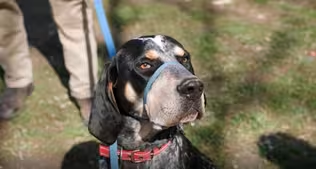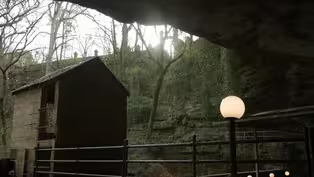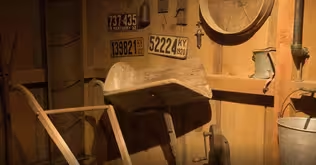
The Official Burt the Cat Fanclub Newsletter, the Story
Clip: Season 31 Episode 2 | 5m 57sVideo has Closed Captions
The Official Burt the Cat Fanclub Newsletter was a newspaper that ran in Louisville starting in 1996
From the late 80s until the early 2000s, the Louisville underground music scene was thriving. The Official Burt the Cat Fanclub Newsletter was a newspaper that ran in Louisville starting in 1996, dedicated to covering the underground music of the area, but what is Underground Music? How is it defined? And most importantly, who is Burt the Cat?
Problems playing video? | Closed Captioning Feedback
Problems playing video? | Closed Captioning Feedback
Kentucky Life is a local public television program presented by KET
You give every Kentuckian the opportunity to explore new ideas and new worlds through KET. Visit the Kentucky Life website.

The Official Burt the Cat Fanclub Newsletter, the Story
Clip: Season 31 Episode 2 | 5m 57sVideo has Closed Captions
From the late 80s until the early 2000s, the Louisville underground music scene was thriving. The Official Burt the Cat Fanclub Newsletter was a newspaper that ran in Louisville starting in 1996, dedicated to covering the underground music of the area, but what is Underground Music? How is it defined? And most importantly, who is Burt the Cat?
Problems playing video? | Closed Captioning Feedback
How to Watch Kentucky Life
Kentucky Life is available to stream on pbs.org and the free PBS App, available on iPhone, Apple TV, Android TV, Android smartphones, Amazon Fire TV, Amazon Fire Tablet, Roku, Samsung Smart TV, and Vizio.
Providing Support for PBS.org
Learn Moreabout PBS online sponsorshipFrom the late ‘80s until the early 2000s, the Louisville underground music scene was thriving.
Back in those days, flyers adorned telephone poles promoting local shows.
So, how did people back then engage with music?
That's what our next story aims to find out.
The Official Burt the Cat Fanclub Newsletter was started in 1996, dedicated to covering the underground music of the area.
But just what is underground music?
How is it defined?
And most importantly, who the heck is Burt the Cat?
Let's find out.
[music playing] [music playing] Underground music is the music of your neighborhood.
It's your friends playing music in their garages.
I guess it's probably defined as in opposition to what would be mainstream or commercial music.
Underground could refer to a subject matter of lyrics.
It could refer to musical styles.
It's itself and trust that you might just be interested in coming to it.
The Burt the Cat, it's basically a zine, locally published.
It includes reviews of shows that happen, lots of photos, some commentary.
Another thing that I think is really cool is it has a lot of ads.
So, it also documents sort of the business history of Louisville and the venues.
So, one of the things about Louisville, at least back in the day, was just we would have maybe one venue or two venues and then they would go out of business, you know.
And so, it's nice to also have that documentation.
The Official Burt the Cat Fanclub Newsletter started in February of 1996.
We approached the community almost like it was People magazine, where the local community, if you were showing up to shows, you could end up in the paper.
A big part of my shtick as a reporter was to talk about conversations I had with people.
And it was kind of a running joke that because I was trying to hit so many shows, I would show up late, and I'd miss the opener.
And I'd take a quote from somebody that did see the opener and report what they told me.
The basic bones of it was a collection of comics reviews, a collection of record reviews, my journal, my nightlife journal, which was, on occasion, referred to as the Curry Journal in a pun of the local newspaper.
My intention at that point was to promote these bands and this community, this music, because it was important to me.
There was a gonzo approach, but it was a matter of wanting people to be involved, to connect, and like the title of the paper was, it was a fan club.
It wasn't a real club.
But if you were there, you were a member.
As far as choosing Burt as the mascot, he was brought to me by a friend in the neighborhood.
She said she found this kitten and she handed it to me.
The affection for Burt was overwhelming.
And the fellow that ran the Rocket House, the house on Fourth Street, hosted all these underground bands.
He suggested to me that when I started my tabloid, I should give it an obtusely long name.
I came up with the Official Burt the Cat Fanclub Newsletter.
That was the official title of the paper.
But every issue, because of my background in comics and National Lampoon and MAD magazine and fanzines, every issue would have a different title.
And so the branding was the cat.
The branding was Burt.
I cast his personality into the paper.
I am the director of the Oral History Center here at the University of Louisville Archives and Special Collections.
I'm also one of the manuscript archivists and one of the founding archivists of the LUMA Project, which stands for Louisville Underground Music Archive.
The LUMA Project is the project to collect materials related to the underground music scene here in Louisville, Kentucky.
Two law school librarians brought a handful of Burt the Cats and donated them.
But we only have a few issues.
So, I called Paul Curry and I said, “Hey, Paul Curry, can we get some, you know, can you send the remaining issues?"
So, that's kind of how it started.
We all just said, “We got to - Let's do this now.
Let's get started.” I don't think we had any documentation on the local sort of punk underground scene before we got those Burts.
If we capture this stuff, who knows who gets inspired by it 20, 30, 40, 50 years from now, and it feels good to be able to give away something to someone who values it.
We value it.
We think it's important.
The fact that somebody else values it and thinks it's important, it's easy to make a handshake over that.
I think it's important for it to exist for a number of reasons.
It is part of the cultural history of Louisville, Kentucky.
It's an important part to many people who participated in it.
It shows cooperation, community, the power of art and music to bring people together.
That's why I think it's important.
[music playing]
Video has Closed Captions
Clip: S31 Ep2 | 8m 39s | The Kentucky town whose mayor is a... dog? (8m 39s)
Video has Closed Captions
Clip: S31 Ep2 | 6m 9s | Explore Lost River Cave and discover the inspiring conservation efforts that protect it. (6m 9s)
Preserving the History of the Commonwealth
Video has Closed Captions
Clip: S31 Ep2 | 3m 8s | Chip visits the Thomas D. Clark Center for Kentucky History in Frankfort. (3m 8s)
Providing Support for PBS.org
Learn Moreabout PBS online sponsorshipSupport for PBS provided by:
Kentucky Life is a local public television program presented by KET
You give every Kentuckian the opportunity to explore new ideas and new worlds through KET. Visit the Kentucky Life website.
















